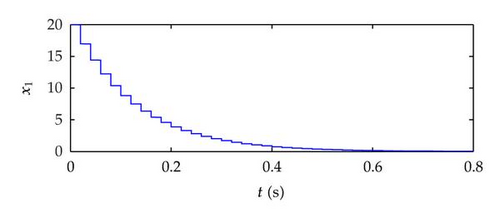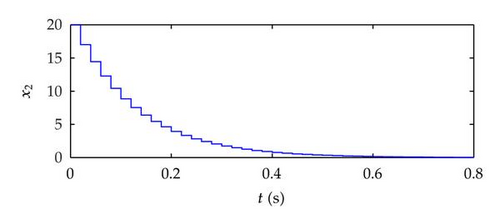Stability Analysis of Predator-Prey System with Fuzzy Impulsive Control
Abstract
Having attracted much attention in the past few years, predator-prey system provides a good mathematical model to present the correlation between predators and preys. This paper focuses on the robust stability of Lotka-Volterra predator-prey system with the fuzzy impulsive control model, and Takagi-Sugeno (T-S) fuzzy impulsive control model as well. Via the T-S model and the Lyapunov method, the controlling conditions of the asymptotical stability and exponential stability are established. Furthermore, the numerical simulation for the Lotka-Volterra predator-prey system with impulsive effects verifies the effectiveness of the proposed methods.
1. Introduction
Since Volterra presented the differential equation to solve the issue of the sharp change of the population of the sharks (predator) and the minions (prey) in 1925, the predator-prey system has been applied into many areas and played an important role in the biomathematics. Much attention has been attracted to the stability of the predator-prey system. Brauer and Soudack studied the global behavior of a predator-prey system under constant-rate prey harvesting with a pair of nonlinear ordinary differential equations [1]. Xu and his workmates concluded that a short-time delay could ensure the stability of the predator-prey system [2]. After analyzing the different capability between the mature and immature predator, Wang and his workmates obtained the global stability with the small time-delay system [3]. Li and his partners studied the impulsive control of Lotka-Volterra predator-prey system and established sufficient conditions of the asymptotic stability with the method of Lyapunov functions [4]. Liu and Zhang studied the coexistence and stability of predator-prey model with Beddington-DeAngelis functional response and stage structure [5]. Li did some work on the predator-prey system with Holling II functional response and obtained the existence, uniqueness and global asymptotic stability of the in random perturbation [6]. Furthermore, Ko and Ryu studied the qualitative behavior of nonconstant positive solutions on a general Gauss-type predator-prey model with constant diffusion rates under homogenous Neumann boundary condition [7]. Additionally, many papers discussed the predator-prey system with other different methods, such as LaSalle’s invariance principle method [8], Liu and Chen’s impulsive perturbations method [9], and Moghadas and Alexander’s generalized Gauss-type predator–prey model [10].
In recent years, fuzzy impulsive theory has been applied to the stability analysis of the non-linear differential equations [11–15]. However, it should be admitted that the stability of fuzzy logic controller (FLC) is still an open problem. It is well-known that the parallel distributed compensation technique has been the most popular controller design approach and belongs to a continuous input control way. It is important to point out that there exist many systems, like the predator-prey system, which cannot commonly endure continuous control inputs, or they have impulsive dynamical behavior due to abrupt jumps at certain instants during the evolving processes. In this sense, it is the same with communication networks, biological population management, chemical control, and so forth [16–23]. Hence, it is necessary to extend FLC and reflect these impulsive jump phenomena in the predator-prey system. Until recently, few papers talk about the stability of Lotka-Volterra predator-prey system with fuzzy impulsive control. In this paper, the writer will study the robustness of the predator-prey system by the fuzzy impulsive control based on the T-S mathematical model.
The rest of this paper is organized as follows. Section 2 describes the Lotka-Volterra predator-prey system and T-S fuzzy system with impulsive control. In Section 3, the theoretic analysis and design algorithm on stability of the impulsive fuzzy system are performed. Numerical simulations for the predator-prey system with impulsive effects are carried out with respect to the proposed method in Section 4. Finally, some conclusions are made in Section 5.
2. Problem Equation
Lemma 2.1. , where x(t) ∈ Rn is the state variable, and f ∈ C[Rn, Rn] satisfiesf(0) = 0, is a vector field defined over a compact region W⊆Rn. By using the methods introduced in [24], one can construct fuzzy model for system (2.1) as follows.
Control Rule i (i = 1,2, …, r): IF z1(t) is Mi1, z2(t) is Mi2…, and zp(t) is Mip, THEN , where r is the number of T-S fuzzy rules, and z1(t), z2(t), …, zp(t) are the premise variables, each Mij (j = 1,2, …, p) is a fuzzy set, and Ai ∈ Rn×n is a constant matrix.
Thus, the nonlinear equation can be transformed to the following linear equation.
If x2(t) is Mi
Correspondently, with center-average defuzzifier, the overall T-S fuzzy impulsive system can be represented as follows:
Obviously, .
Lemma 2.2. If P is a real semipositive matrix, then a real matrix C exists, making P = CTC.
3. Stability Analysis
Theorem 3.1. Assume that λi is the maximum eigenvalue of , let λ(α) = max i {λi}, 0 < δj = τj − τj−1 < ∞ is impulsive distance [25]. If λ(α) ≥ 0 and there exists a constant scalar ε > 1 and a semipositive matrix P, such that
where
Then the system (2.5) is stable globally and asymptotically.
Proof. Let the candidate Lyapunov function be in the form of
For t = τj, we have
Theorem 3.2. Assume that λi is the maximum eigenvalue of , let λ(α) = max i {λi}, 0 < δj = τj − τj−1 < ∞ is impulsive distance. If λ(α) < 0 and a constant scalar 0 ≤ ε < −λ(α) exists, such that
Then the system (2.5) is stable globally and exponentially.
Proof. Let the candidate Lyapunov function be in the form of
From (3.13), we obtain
Note that 0 ≤ ε < −λ(α), thus λ(α) + ε < 0. So the system (2.5) is stable globally and exponentially.
Next, we consider some special cases of the two theorems. Assume that K = Ki,j and σ = σj in the two theorems above, so we can have the following corollary.
Corollary 3.3. Let λi be the largest eigenvalue of [A + AT], (i = 1,2, …, r), λ(α) = max i {λi} > 0. If there exists a constant ε > 1 and a real semi-positive P such that
Corollary 3.4. Let λi be the largest eigenvalue of [A + AT](i = 1,2, …, r), λ(α) = max i {λi} < 0. If there exists a constant 0 ≤ ε < −λ(α) and a real semi-positive P such that
4. Numerical Simulation
In this section, we present a design example to show how to perform the impulsive fuzzy control on the Lotka-Volterra predator-prey systems with impulsive effects. Especially, the biological systems are very complex, nonlinear, and uncertain. As a result, they should be represented by fuzzy logical method with linguistic description.
Solving From (2.3), we have the following impulsive fuzzy control for the above predator-prey model.
Rule i IF x2(t) is Mi, then
where,
due to x2(t)∈[0, d] = [0,0.12], and M1(x2(t)) = x2(t)/d, M2(x2(t)) = −x2(t)/d.
Let ε = 1.2, δ = 0.05, P = I, μ1 = 0.2, μ2 = 0.16, r12 = 0.10, r21 = 0.31.
From Theorem 3.1 and Corollary 3.3, we can get that λ(α) = 0.194.
Thus, we have chosen diag ([−0.82, − 0.82]) as impulsive control matrix, such that
Thus, from Theorem 3.1 and Corollary 3.3, we can conclude that the numerical example is globally stable. The phase portrait of the system with impulsive control is shown in Figure 1.


5. Conclusions
The impulsive control technique, which was proved to be suitable for complex and nonlinear system with impulsive effects, was applied to analyzing the framework of the fuzzy systems based on T-S model and the proposed design approach. First, the robustness of the Lotka-Volterra predator-prey system based on the fuzzy impulsive control was carefully analyzed. Then, the overall impulsive fuzzy system was obtained by blending local linear impulsive system. Meanwhile, the asymptotical stability and exponential stability of the impulsive fuzzy system were derived by Lyapunov method. Finally, a numerical example for predator-prey systems with impulsive effects was given to illustrate the application of impulsive fuzzy control. The simulation results show that the proposed method was effective.
Acknowledgments
This work was supported by the National Natural Science Foundation of China, Project no. 50975300 and the Foundation of Education Department of Guangxi, China, Project no. 200808MS079.




